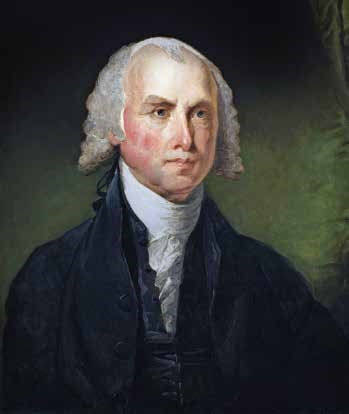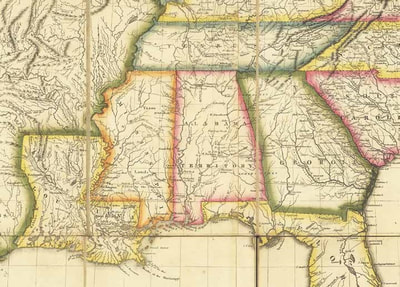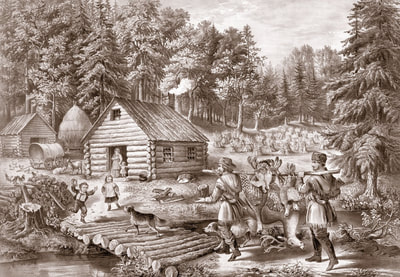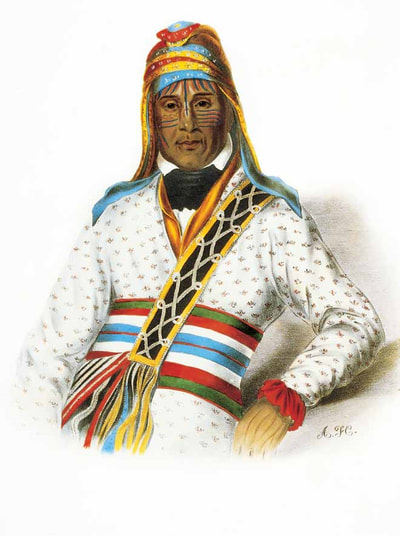With the proverbial stroke of a pen in the nation’s capital, Alabama’s long road to independent territorial status entered its final act on March 3, 1817. The newly designated Alabama Territory, the eastern half of the enormous tract of the American southwestern frontier known as the Mississippi Territory, on that date began its transition to a separate political entity by the terms of an enabling act passed by Congress and signed into law by Pres. James Madison. The act set out the process by which the western portion of the territory, the future state of Mississippi, would enter the Union and organized the eastern section into the Alabama Territory. For the first time since the formation of the Mississippi Territory a generation prior in 1798, the circuitous path towards statehood for the region at last lay clear.
The new Alabama Territory, only recently beginning to match the rapid population growth of its sectional rival—which was itself poised to enter the Union as the state of Mississippi—would barely have time to assume its place on maps before it had its own star on the American flag. The rapid pace of development stunned observers. Long referred to as the “backwoods” of the Mississippi Territory, what became Alabama had seemed to languish compared to the steady pace of growth of the territory’s western section. The southernmost portion of the new Alabama Territory had actually been a Spanish colony less than five years before its creation, and most of the territory’s other lands had officially been Native American domain as recently as a decade earlier. The region’s relatively small population had grown begrudgingly accustomed to being overshadowed and overlooked by the Mississippi Territory’s seat of government at Natchez, which wielded influence disproportionate to its size. The Alabama Territory’s residents thus cherished their opportunity for self-determination with a particular relish in the wake of the frustration and angst bred by their many years of being governed by what they perceived to be faraway aristocrats.
With the Mississippi Territory’s center of government, largest population center, and leading trading hubs oriented towards the mighty Mississippi River, easterners had with some justification long felt neglected. As early as 1803, they had complained of being a virtual fiefdom of remote and aloof Natchez, initiating the first of many concerted efforts to divide the sprawling territory in a way suitable to local interests. Even up to the very day of the Alabama Territory’s creation, residents had passionately debated whether to divide the immense Mississippi Territory and where exactly to place the border if it should enter the Union as two states rather than one. Eastern section fortunes rather suddenly and unexpectedly began to change with the cession of over twenty million acres of choice lands by the Creeks following their defeat in the brief and bloody Creek War, which raged within what became Alabama from 1813 to 1814. Alabama would experience immigration quite unlike anything the nation had ever witnessed in the aftermath. In 1813 the portion of the territory that would become Mississippi claimed over three times the number of settlers as the future state of Alabama. Within a decade Alabama had not only out-stripped the Magnolia State but was also on its way to more than doubling its population by 1830. A fierce regional pride, born of the long-simmering jealous resentment of early arrivals and stoked by anxious ambition of the more recent, would color the development in Alabama.
The Alabama Territory’s future appeared exceptionally bright in large part because its legendarily rich lands promised the creation of great wealth in short order. Newspapers, traveler’s guides, and personal correspondence offered glowing descriptions of the land and its potential, generally characterizing the territory as a sort of modern Eden. None of the breathless assessments was more enthusiastic or comprehensive than a description in the New York Herald just a few months after the territory’s formation:
With the Mississippi Territory’s center of government, largest population center, and leading trading hubs oriented towards the mighty Mississippi River, easterners had with some justification long felt neglected. As early as 1803, they had complained of being a virtual fiefdom of remote and aloof Natchez, initiating the first of many concerted efforts to divide the sprawling territory in a way suitable to local interests. Even up to the very day of the Alabama Territory’s creation, residents had passionately debated whether to divide the immense Mississippi Territory and where exactly to place the border if it should enter the Union as two states rather than one. Eastern section fortunes rather suddenly and unexpectedly began to change with the cession of over twenty million acres of choice lands by the Creeks following their defeat in the brief and bloody Creek War, which raged within what became Alabama from 1813 to 1814. Alabama would experience immigration quite unlike anything the nation had ever witnessed in the aftermath. In 1813 the portion of the territory that would become Mississippi claimed over three times the number of settlers as the future state of Alabama. Within a decade Alabama had not only out-stripped the Magnolia State but was also on its way to more than doubling its population by 1830. A fierce regional pride, born of the long-simmering jealous resentment of early arrivals and stoked by anxious ambition of the more recent, would color the development in Alabama.
The Alabama Territory’s future appeared exceptionally bright in large part because its legendarily rich lands promised the creation of great wealth in short order. Newspapers, traveler’s guides, and personal correspondence offered glowing descriptions of the land and its potential, generally characterizing the territory as a sort of modern Eden. None of the breathless assessments was more enthusiastic or comprehensive than a description in the New York Herald just a few months after the territory’s formation:
Considering the great extent of the territory of Alabama—the vast bodies of fertile lands…in a country too, which is congenial to the culture of one of the most valuable staples a planter can raise; privileged with three noble rivers, of extensive, easy and safe navigation—blessed also, with one of the most delightful climates in the world…. I say, with all these privileges and luxurious bounties of nature…who is not ready to exclaim that Alabama is an American Canaan
It would have been easy to miss the signs of impending dynamic expansion if one actually visited the Alabama Territory in 1817, however. The new territory’s inhabitants generally dressed plainly, often in simple, homemade fabrics and not a few in hunting shirts and leggings. They subsisted in large part on the simplest of fare: corn, pork, wild game, and milk. They were fond of drink, and music and dance formed the core of their entertainment outside their primary pastime of hunting. Only a few widely scattered settlements within Alabama’s mere seven counties contained the bulk of its settlers, most of which could be described more as groupings of hastily built log cabins and haphazard shanties than what the word “town” usually connotes in the mind’s eye. In the extreme south lay the sleepy trading post of Mobile, a community of only a few hundred inhabitants whose long legacy of colonial rule still made it something a bit more foreign than American. To its immediate north were a few isolated clusters of settlements along the Tensaw and Tombigbee Rivers, with the village of St. Stephens being the closest thing to an established town among them. In the northern extreme of the new territory lay the nascent settlements of the Tennessee Valley, the town of Huntsville preeminent. Brought into existence itself less than a decade earlier, the community was in the middle of a meteoric rise that would soon make it the principal city in the Alabama Territory. Inadequate roads connected these scattered villages, which at this early date often had little association with each other owing to trading patterns determined by geography. To a great degree, the core areas of all this enterprise lay flanked by the remnants of the ancestral domains of the Choctaws, Chickasaws, Cherokees, and Creeks. While the inexorable tide of American immigration would soon wash away those ancient borders and ultimately decide the native inhabitants’ place in the new state with devastating finality, exactly how and when this would be accomplished could not be known as the territory prepared for the final push towards asserting itself among sovereign states.
Despite all of its advantages, the Alabama Territory was in truth still a raw frontier. Its preparation for statehood would inherently be trying, since virtually everything necessary to establish an independent political entity had to be created, formed, or organized in short order. The brief but eventful dramatic interlude in which Alabama’s founders did this not only accomplished the immediate goal of statehood with remarkable haste but also laid the foundation for the ultimate transformation of the heart of the Old Southwest into the Heart of Dixie within the span of a generation. Along the way the state-in-the-making con-fronted all the problems and issues that typified the American experience of the era. It would be challenged by class conflict, rattled by rumors of wars, shaken by economic set-back, riven by sectional rivalry, tested in channeling greed and personal ambition into instruments for the greater good, and divided in determining the place of Indians and slaves in its society. The ways it dealt with these and a host of other issues would reverberate far into statehood, even to this very day. The story of the Alabama Territory, then, is nothing less than the story of Alabama becoming the state we know today.
Despite all of its advantages, the Alabama Territory was in truth still a raw frontier. Its preparation for statehood would inherently be trying, since virtually everything necessary to establish an independent political entity had to be created, formed, or organized in short order. The brief but eventful dramatic interlude in which Alabama’s founders did this not only accomplished the immediate goal of statehood with remarkable haste but also laid the foundation for the ultimate transformation of the heart of the Old Southwest into the Heart of Dixie within the span of a generation. Along the way the state-in-the-making con-fronted all the problems and issues that typified the American experience of the era. It would be challenged by class conflict, rattled by rumors of wars, shaken by economic set-back, riven by sectional rivalry, tested in channeling greed and personal ambition into instruments for the greater good, and divided in determining the place of Indians and slaves in its society. The ways it dealt with these and a host of other issues would reverberate far into statehood, even to this very day. The story of the Alabama Territory, then, is nothing less than the story of Alabama becoming the state we know today.




 RSS Feed
RSS Feed